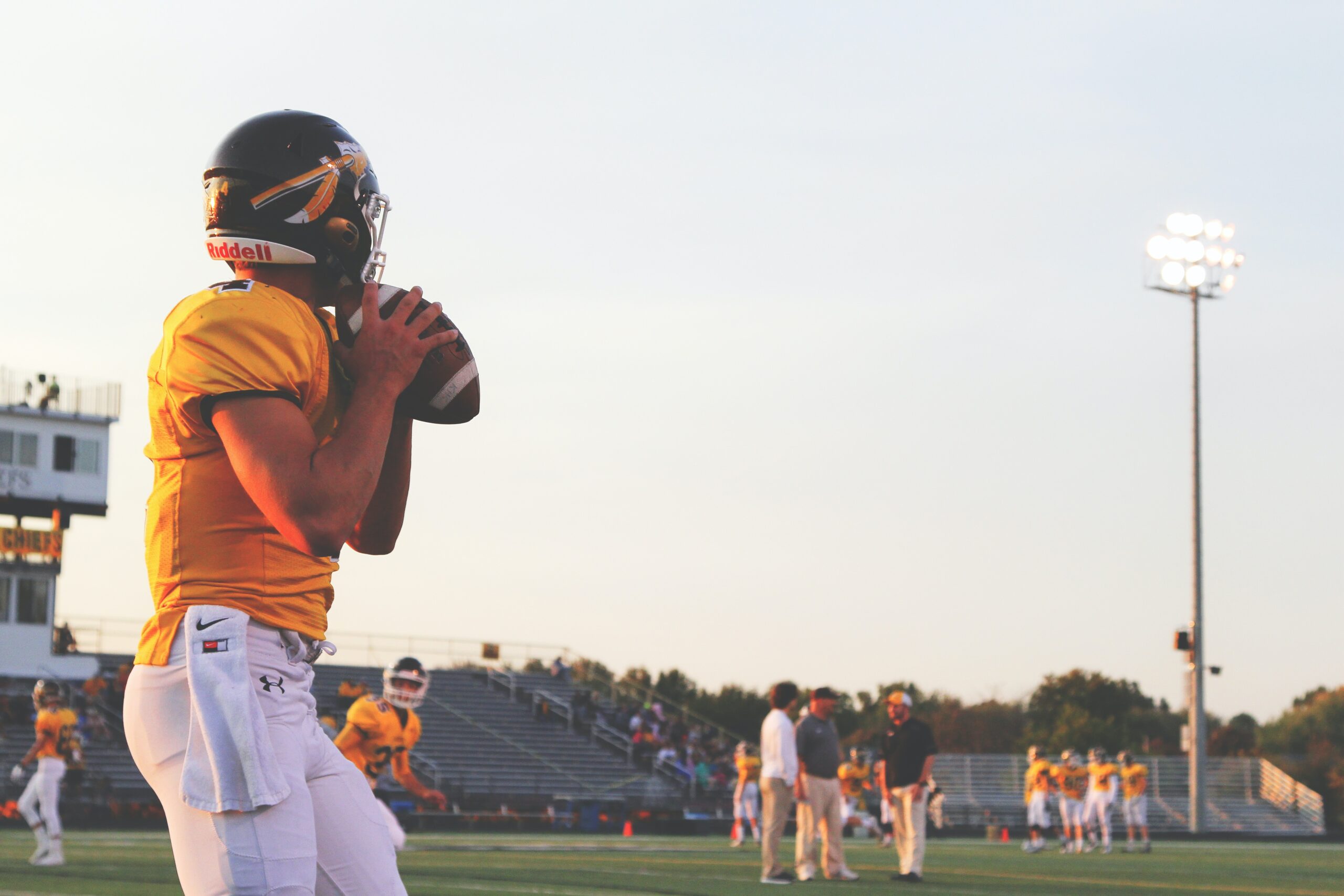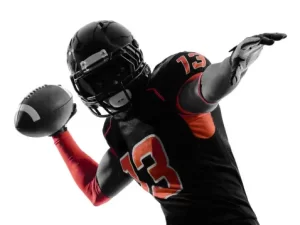The check down play in football is a crucial aspect of a quarterback’s strategy when trying to progress forward on the field. What is a Check Down in Football? A check down occurs when the quarterback attempts to complete a short, accurate pass. Typically the short pass it to a running back or tight end, as a last resort when the primary targets designed by the play call are covered. In essence, the quarterback has “checked down” his list of receivers, identifying the most viable option under the current circumstances.
Check downs can act as safety nets for quarterbacks, preventing negative outcomes such as a sack or an incomplete pass, by generating a positive play out of a difficult situation. These short passes are often viewed as late reads, meaning the quarterback will only choose the check down option once they become aware that nearby receivers are covered. This strategy allows signal-callers to make the most of challenging scenarios in gameplay, giving their team a fighting chance at advancing down the field.
The importance of check downs lies in their ability to save potentially unsuccessful plays and turn them into gains, albeit often small ones. They showcase the adaptability quarterbacks must possess when facing elite coverage or unexpected pressures, and can serve as a crucial element in a team’s overall success. By understanding the role of the check down in American football, fans can gain insight into the strategic thinking that drives the game as well as appreciate the quick decision-making required on the field.
Contents
Understanding Check down in Football
Definition of Check down
A check down in football is a short-yardage pass attempt that the quarterback makes to a running back, tight end, or any eligible receiver when all the main wide receivers are well-defended, in order to avoid being sacked. The term “checked down” means that the quarterback has spent the time, around 3-4 seconds, looking downfield for each available main receiver before deciding to opt for a short or safer pass.
Purpose of Check down
The main purpose of a check down is to provide the quarterback with a last resort option when the primary passing options are unavailable or covered by the defense. This helps to:
- Gain positive yardage instead of risking a sack or a loss of yardage
- Keep the play alive and maintain pressure on the defense
- Minimize the risk of a turnover, as check downs are typically shorter and safer passes
By implementing check downs in their passing strategy, teams can keep their offense moving, maintain possession of the ball, and avoid potential big losses or risky plays that could lead to unfavorable outcomes. Though check downs may not always result in big gains, they play a crucial role in sustaining offensive drives and increasing the overall efficiency of the team’s passing game.
Quarterback’s Role in Check down
Decision Making
In a football game, the quarterback is responsible for deciding where to throw the ball. When primary receivers are covered or the intended play is disrupted, the quarterback must make a quick decision to avoid a sack or turnover. Check downs are one of these decisions, offering a safe, short-yardage attempt when preferred options are not available. The quarterback must have a good understanding of the play, scanning the field in a matter of seconds to determine if the check down route is the best course of action.
Reading the Defense
Reading the defense is crucial for quarterbacks in determining when to execute a check down. They must be able to identify the defensive coverage, recognizing if the primary receivers are well-defended or if the defense is exposing weaknesses that could be exploited by a short pass. The quarterback must also assess the pressure they’re facing from the defense, as pocket collapse or an imminent sack can necessitate a quick check down pass. By effectively reading the defense and making split-second decisions, a quarterback can mitigate risks and gain positive yardage with a check down pass.
Types of Check down Options
In football, a check down is a short, safe pass that a quarterback throws to an eligible receiver when primary targets are covered. There are various check down options available for the quarterback, which can involve running backs, tight ends, or wide receivers. This section will discuss these different check down options in more detail.
Running Back Check downs
Running back check downs typically involve the running back positioning themselves a short distance away from the line of scrimmage, creating a safety valve for the quarterback. These passes are often quick and accurate, allowing the running back to catch the ball and potentially gain a few yards if open field is available. Some common running back check down routes include:
- Swing routes: The running back moves to the outside of the field, creating a short, horizontal target for the quarterback.
- Flat routes: The running back moves parallel to the line of scrimmage towards the sideline, often as a quick outlet option.
- Screen routes: The running back delays their release, allowing the offensive lineman to create a barrier between them and the defense, providing an opportunity for a bigger gain after the catch.
Tight End Check downs
Tight end check downs generally involve the tight end positioning themselves closer to the line of scrimmage and running short routes. These can provide a quick and reliable option for the quarterback when other options are covered. Some common tight end check down routes include:
- Hook routes: The tight end runs a few yards downfield, then turns back towards the quarterback to receive the pass.
- Slant routes: The tight end runs diagonally towards the center of the field, creating separation from the defender and allowing the quarterback to make a quick, short pass.
- Delay routes: The tight end releases into a short route after blocking for a brief moment, providing an unexpected receiving option.
Josh Rosen pulled a Houdini 😱😱 @josh3rosen pic.twitter.com/541du0WPUa
— The Checkdown (@thecheckdown) August 9, 2019
Wide Receiver Check downs
Wide receiver check downs are less common, as wide receivers typically run longer routes. However, in situations where a short pass is needed, wide receivers can provide viable check down options. Some wide receiver check down options include:
- Quick slants: The wide receiver takes a few steps downfield before cutting diagonally inward, allowing the quarterback to make a short pass.
- Drag routes: The wide receiver runs parallel to the line of scrimmage, crossing beneath other receivers’ routes and providing a short, open target.
- Hitch routes: The wide receiver runs downfield and turns back towards the quarterback, providing a simple target for a few quick yards.
In summary, check down passes provide a safe option for the quarterback when primary targets are covered. Running backs, tight ends, and wide receivers can all be utilized as check down options, depending on the situation and the routes being run.
Check down Strategies in Football
Game Situation Considerations
A check down, in football, is a short pass thrown by the quarterback to a running back or tight end when the primary wide receivers are covered. It serves as a safe option to avoid a sack and can be an effective part of an offensive scheme. To use check downs strategically, several factors should be considered, such as:
- Down and distance: Check downs are often utilized on third and long situations when the defensive coverage is focused on preventing deep passes.
- Pass rush: If the quarterback is frequently pressured by the defense, check downs can provide a quick and safe outlet to counteract the aggressive pass rush.
- Defensive alignments: Check downs can be more effective against specific defensive alignments, such as zone coverage, where gaps in the defense can be exploited for short gains.
Incorporating Check downs in Offensive Schemes
To effectively incorporate check downs in an offensive scheme, coaches and quarterbacks should focus on:
- Identifying favorable matchups: It is essential to identify when a running back or tight end has an advantage over a linebacker or another defender in coverage. This can lead to successful check downs and potentially result in substantial gains.
- Developing proper timing: The quarterback should practice recognizing when the primary options are not available and quickly shift focus to the check down receiver. This requires efficient scanning of the field and effective decision-making.
- Designing plays with check down options: Including check down options in various passing plays can help keep the defense on their toes, providing additional threats to account for while trying to defend the primary receivers.
By considering these factors and following these strategies, check downs can become an integral and effective part of any offensive scheme.



